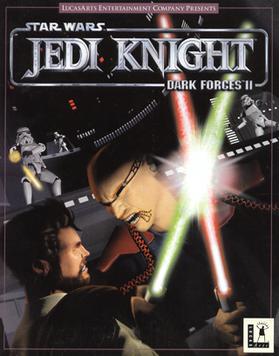
Star Wars Jedi Knight: Dark Forces II is a 1997 first-person shooter video game developed and published by LucasArts for Windows. It is the sequel to 1995's Star Wars: Dark Forces, and the second installment in the Star Wars: Jedi Knight series. The story, set in the fictional Star Wars expanded universe one year after the film Return of the Jedi, follows returning protagonist Kyle Katarn, a mercenary working for the New Republic, who discovers his connection to the Force and "The Valley of the Jedi", an ancient source of power. With his father having been murdered years prior by the Dark Jedi Jerec and his followers over the Valley's location, Katarn embarks on a quest to confront his father's killers and find the Valley before they do.
Star Wars: Customizable Card Game (SW:CCG) is an out-of-print customizable card game based on the Star Wars fictional universe. It was created by Decipher, Inc., which also produced the Star Trek Customizable Card Game and The Lord of the Rings Trading Card Game. The game was produced from December 1995 until December 2001. Since 2002, the game has been maintained by the Star Wars CCG Players Committee, with new virtual cards being released every few months and the capability to play both in person and online.

The Lord of the Rings Trading Card Game is an out-of-print collectible card game produced by Decipher, Inc. Released November 2001, it is based on Peter Jackson's The Lord of the Rings film trilogy and the J. R. R. Tolkien novel on which the films were based. Decipher also had the rights to The Hobbit novel but did not release any cards based on it. In addition to images taken from the films, in 2004 Weta Workshop produced artwork depicting characters and items from the novel absent from the films for use on cards. In 2002, LOTR TCG won the Origins Awards for Best Trading Card Game of 2001 and Best Graphic Presentation of a Card Game 2001. Decipher's license to The Lord of the Rings expired on July 30, 2007, after which all official promotion and distribution of the game stopped.

Star Wars: The Trading Card Game is an out-of-print collectible card game produced by Wizards of the Coast (WotC). The original game was created by game designer Richard Garfield, the creator of the first modern trading card game, Magic: The Gathering. After its initial release in April 2002, the game was 'put on indefinite hold' by WotC in late 2005. The Star Wars Trading Card Game Independent Development Committee was created by a group of fans to continue development of the game. They design new cards that are available as free downloads at their website.

The Star Trek Customizable Card Game is an out-of-print collectible card game based on the Star Trek universe. The name is commonly abbreviated as STCCG or ST:CCG. It was first introduced in 1994 by Decipher, Inc., under the name Star Trek: The Next Generation Customizable Card Game. The game now has two distinct editions, though both forms of the game have many common elements.
Decipher, Inc. is an American gaming company headquartered in Norfolk, Virginia, US. The company began with three puzzles marketed as "Decipher," subsequently marketing party games and Pente sets. After 1994, Decipher produced collectible card and role-playing games — including their longest-running product, How to Host a Murder Mystery series. Other popular works have included many different card games. Since 2002, Decipher has released two licensed role-playing games: Star Trek RPG and The Lord of the Rings Roleplaying Game.

Call of Cthulhu: The Card Game is an out-of-print card game produced and marketed by Fantasy Flight Games from 2004 to 2015. It is based on Chaosium's Call of Cthulhu role-playing game, the writings of H. P. Lovecraft, and other Cthulhu Mythos fiction.

The Star Wars Roleplaying Game is a d20 System roleplaying game set in the Star Wars universe. The game was written by Bill Slavicsek, Andy Collins and J. D. Wiker and published by Wizards of the Coast in late 2000 and revised in 2002. In 2007, Wizards released the Saga Edition of the game, which made major changes in an effort to streamline the rules system.
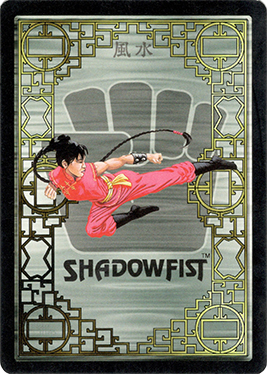
Shadowfist is a card game created by Robin Laws and Jose Garcia. It was released in June 1995 as a collectible card game (CCG), but was shifted to a fixed distribution of cards as of 2013. It shares the same background as Feng Shui, a role-playing game created by Laws and Garcia and released the following year. In September 2018 ownership of Shadowfist transferred to Vetusta Games.

The Harry Potter Trading Card Game is an out-of-print collectible card game based in the world of J. K. Rowling's Harry Potter novels. Created by Wizards of the Coast in August 2001, the game was designed to compete with the Yu-Gi-Oh!, Pokémon and Magic: The Gathering card games. Its release was timed to coincide with the theatrical premiere of the first film in the series. The game was praised for the way it immersed children in the Harry Potter universe. At one point the game was the second best selling toy in the United States; however, it is now out of print.
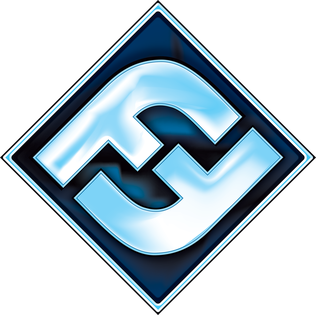
Fantasy Flight Games (FFG) is a game developer based in Roseville, Minnesota, United States, that creates and publishes role-playing, board, card, and dice games. As of 2014, it is a division of Asmodee North America.
The Universal Fighting System (UFS), released in 2006 and rebranded as UniVersus in 2021, is a collectible card game published by UVS Games. Games of UFS represent a fight between two characters in hand-to-hand combat. Characters are drawn from original properties as well as a number of licensed ones, such as Mega Man, Street Fighter, The King of Fighters XIII and Darkstalkers. The sets are cross-compatible – cards from multiple licenses can be included in the same deck, and characters from different universes may face each other in a match.
Star Wars PocketModel Trading Card Game is an out-of-print tabletop game manufactured by WizKids, Inc. that debuted in 2007, based on the Star Wars universe. The game was designed by Mike Elliott and Ethan Pasternack.

Battlestar Galactica Collectible Card Game is an out-of-print collectible card game based on the Battlestar Galactica science fiction media franchise. The game, published by WizKids, saw first release in May 2006 and was officially canceled in March 2007.

The Buffy the Vampire Slayer Collectible Card Game is an out-of-print trading card game based on Buffy the Vampire Slayer. It was released in December 2001 by Score Entertainment. As of January 2004, Score Entertainment no longer holds the rights to this game. Hence, no further production runs or expansions for the game are planned.

Young Jedi Collectible Card Game is an out-of-print collectible card game published by Decipher, Inc. that was released in May 1999. It was based on the events and characters of the movie The Phantom Menace in the Star Wars universe. Seven expansions were released before the game was discontinued in September 2001.
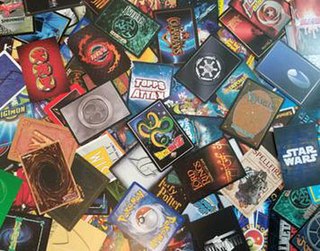
A collectible card game (CCG), also called a trading card game (TCG) among other names, is a type of card game that mixes strategic deck building elements with features of trading cards. It was introduced with Magic: The Gathering in 1993.
Star Wars: The Card Game is a Living Card Game (LCG) produced by Fantasy Flight Games published from 2012 to 2018. It is a two-player card game set in the Star Wars universe. It puts one player in command of the light side of the Force, and one player in command of the dark side of the Force. The Balance of the Force expansion allows multi-player games. The game is set within the time-frame of the original Star Wars trilogy.
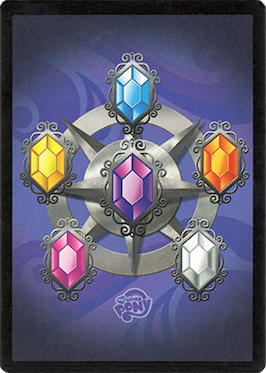
The My Little Pony Collectible Card Game is a two-player collectible card game based on the animated television series My Little Pony: Friendship Is Magic. It is produced by Enterplay LLC under license from Hasbro, and follows from Enterplay's previous work to produce a trading card series based on the same show.















